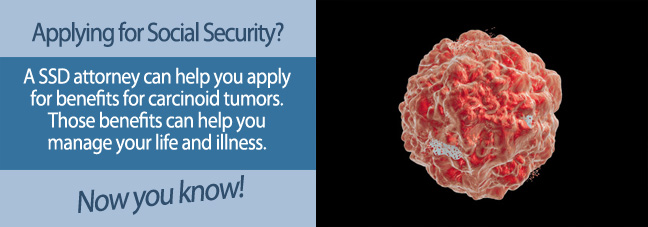The Social Security Administration (SSA) has two programs that provide financial assistance to those with a disability that prevents them from maintaining gainful employment.
While one is aimed at applicants with a work history and the other is designed to assist low-income households, they both require you to meet certain medical criteria to receive benefits.
Carcinoid Tumors Explained
Carcinoid tumors are a form of slow-growing cancer that can appear throughout your body. A subset of neuroendocrine tumors, they generally appear in your digestive tract or lungs first, and then spread to other places in the body.
Depending on where they manifest, carcinoid tumors can inflict a wide range of painful symptoms. When they originate in the lungs, you may experience chest pain, wheezing and shortness of breath, and weight gain in the midsection.
Carcinoid tumors in the digestive tract may cause you to experience abdominal pain, diarrhea, nausea, and rectal bleeding.
As the tumors grow and spread, they can have a significant impact on your daily life, preventing you from working and being financially independent. However, you may be eligible to receive Social Security disability benefits to meet your living expenses and cover medical treatment.

Qualifying for Disability Benefits
Any one of the symptoms listed above can disrupt your daily activities and affect your quality of life, but to qualify for SSA benefits, your condition must be deemed disabling, which means that:
- You are unable to do the type of job you did prior to becoming disabled
- You have a physical or mental condition that prevents you from doing any other type of work
- Your condition has lasted, or is expected to last, at least one year and/or end in death
You must also meet medical criteria for a condition listed in the SSA Blue Book, which is a catalogue of recognized disabilities. Carcinoid tumors can affect more than one system in your body, so there is not a single Blue Book listing for the disease.
In this instance, you have to qualify under a listing that matches your condition and symptoms, such as:
- Listing 13.14—Malignant Neoplastic Diseases of the Lungs
- Listing 13.16—Malignant Neoplastic Diseases of the Stomach or Esophagus
- Listing 13.17—Malignant Neoplastic Diseases of the Small Intestine
- Listing 13.18—Malignant Neoplastic Diseases of the Large Intestine
If the SSA concludes that carcinoid tumors are affecting you in a manner that mirrors the symptoms of any of these conditions, you will likely be approved for benefits.
The Application Process
When applying for SSA disability benefits, you are required to complete a detailed application form along with any medical records that verify your claim. With carcinoid tumors, this could include:
- Images that confirm the location of the tumors
- Surgery and pathology records
- Hospitalization records
- Treatment history
Although the SSA may approve your claim the first time around, the fact is that over half of all initial applications are denied for various reasons. However, there's still hope for your claim because a Social Security Disability attorney or advocate can help. Attorneys and advocates can:
- Explain SSA processes and rules to you
- Ensure that your application contains all required information
- Help you prepare for as well as represent you at an appeal hearing
When the symptoms of carcinoid tumors leave you unable to work, professional and experienced support from an SSD attorney or advocate can increase your chances of getting the financial support you need.